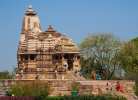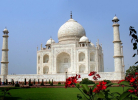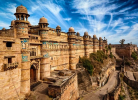Ram Bagh, Agra
-
Famous For Photo Fanatics, History Buffs, Experience Seekers, Nature Lovers
-
Duration of Visit 1 hour onwards
-
Fee No Fee
-
Visiting Time All days of the week 6:00 AM - 6:00 PM
Ram Bagh was one of the ancient Persian styled Mughal gardens of Agra. This garden was well maintained for several centuries under the control of Mughal dynasty until Marathas and then, British took over the garden. Today, most of the parts of this garden is in ruins. However, the greenery and lush vegetation of the land attracts tourists to it.
Where is Ram Bagh Located?
This garden is located in Agra of Uttar Pradesh. You can find cabs, autos and rickshaws from any part of the city to this garden.
- Distance between Ram Bagh and Itimad-Ud-Daulah Tomb – 3 km
- Distance between Ram Bagh and Chini ka Rauza – 500 m
- Distance between Ram Bagh and Taj Mahal -8.1 km
- Distance between Ram Bagh and Agra Fort – 4.9 km
- Distance between Ram Bagh and Agra Cantt – 9.1 km
Why is Ram Bagh Famous?
This is the oldest Mughal garden and one of the eminent Persian styled Mughal gardens of the land. This land stands as the example of architectural skill of Nur Jahan, mother of Shah Jahan (builder of Taj Mahal).
If you are visiting in summer months, this garden is really a paradise. The water channels provide cool breeze, which allows you to rest despite the scorching sun. The garden represent the Islamic version of heaven and this model is incorporated in many Mughal structures, which were built later on.
Emperor Babur was temporarily buried here in the garden in 17th century. Later, his cenotaph was moved to his grand grave in Kabul of Afghanistan.
History of Ram Bagh
The garden was first created by Babur. Later, Nur Jahan, Mughal Empress renovated it by adding many structures to it. The garden was in the control of Marathas during the 18th century. This was when, the garden got its name, Ram Bagh. Prior to that, the garden was called as Aram Bagh (garden of rest). It is said that Emperor Akbar fell in love with the gardener of Aram Bagh. She refused to marry him and thus, he stayed in the garden for six days, doing literally nothing (resting) until she accepted to marry him.
Akbar’s son, Jehangir and his wife took immense care of the garden. When Mughals recaptured Agra in 17th century, he waited in this garden of rest for the auspicious time to enter Agra, again.
Architecture of Ram Bagh
The garden was called as Bagh-i-Gul Afshan, after a garden in Kabul. This garden has Charbagh pattern. According to this pattern, the garden is divided into four parts with the help of waterway and paths. This is an important element of Islamic architecture. According to Quran, the paradise has four water bodies. Each section of the garden denotes each water body of heaven.
The source of water for the garden is the River Yamuna. The water from the river is distributed to every part of the garden via cascades on terraces. There are fountains, island platform, stairs, pavilions and other structures on each side of the water channel.
Entry Fee of Ram Bagh
- Indians and SAARC citizen – INR 15 per person
- Foreigners – INR 200 per head
- Children below age 15 - Free
Visiting Time of Ram Bagh
It is Open from sunrise to sunset.
If you prefer exploring Agra in a luxurious itinerary, it is best recommended to choose the iconic luxury trains scaling the country. Top itineraries to choose to cover Agra are:
- Palace on Wheels – Iconic Itinerary
- Gems of India – Maharajas’ Express
Best Time To Visit Ram Bagh
Evening is the best time to enjoy this garden. Agra is generally a hot region. Thus, it is best to stick with the winter season, which starts in October and ends in March. Some prefer to visit this garden early in the morning, right at the time of sunrise. The choice is yours.
















